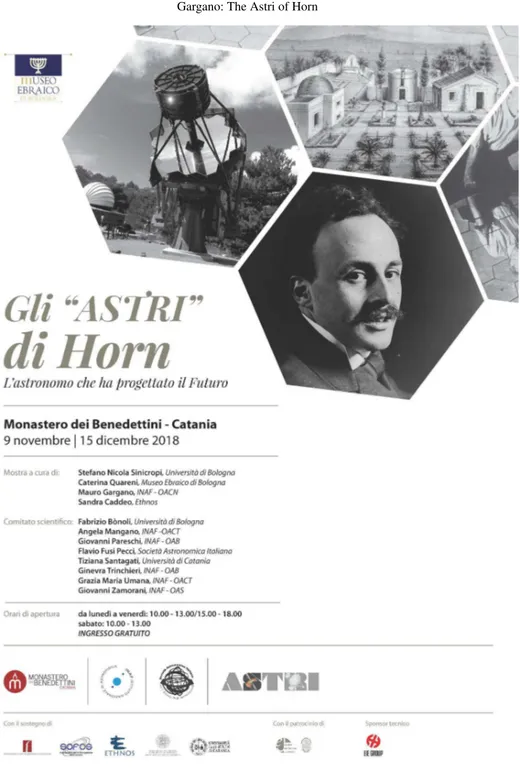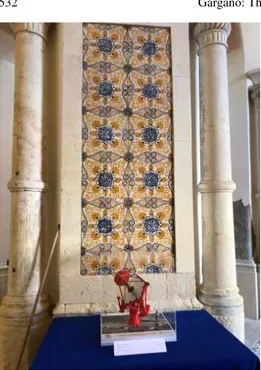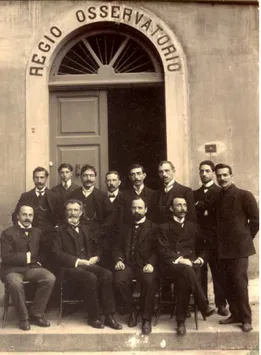2018
Publication Year
2020-05-18T17:04:02Z
Acceptance in OA@INAF
The Astri of Horn: the scientific legacy of astronomer who invented the future
Title
GARGANO, MAURO
Authors
http://hdl.handle.net/20.500.12386/24942
Handle
MEMORIE DELLA SOCIETA ASTRONOMICA ITALIANA
Journal
89
Number
Mem. S.A.It. Vol. 89, 529
c
SAIt 2019 Memoriedella
The Astri of Horn: the scienti c legacy of
astronomer who invented the future
M. Gargano
INAF - Astronomical Observatory of Capodimonte Salita Moiariello, 16 80131 - Napoli , Italy
Abstract. A tribute to Guido Horn d’Arturo in Catania seemed a bit of a stretch. The dedi-cation to him of ASTRI telescope which looks at the incandescent mouths of Etna severely, at the columns of sulfur fumes, and at slopes of the snowy mountain while it scans the sky, could appear outside the context.
1. The Astri of Horn
A superficial reading of the scientific biogra-phy of the astronomer born in Trieste, who de-veloped much of his career in Bologna, could suggest that the first tribute to Horn, and so far the only one, was an acknowledgment im-posed exclusively by the presence in Sicily of the modern tessellated mirror telescope, inher-ited from the astronomer’s original intuition. Actually, a bit like the concept behind the tech-nology developed by Horn d’Arturo for the tes-sellated telescope installed in the Specola of Bologna, the study of archival documents al-lowed us to form and compose the many pieces of the astronomer’s biographical and scientific mosaic and to reconstruct the various phases of the brilliant intuition. The reading of his pri-vate and scientific correspondence made it pos-sible to compose the personal picture of his feelings, of his relationships, and of the morti-fications suffered for the infamous fascist laws in defense of a non-existent Italic race. The analysis of scientific activities, carried out by Horn also during the short stay in Catania, has revealed a much more complex and convinc-ing picture than was known until now both to the specialists in the history of science and to the general public of lovers of modern and
an-cient astronomy. The result of this study shown that the link between Guido Horn d’Arturo and the ASTRI telescope of Serra la Nave has solid roots both in the life of the astronomer and in the history of astronomy in Catania. There are not only the biographical and scientific el-ements of Guido Horn d’Arturo, who began his astronomy career in Catania, to support the choice to celebrate him in Sicily, but in hindsight, the comparison among the scientific and technological visions of the astronomer, the interests in the modern research of the Astrophysical Observatory of Catania and the technological innovation of the ASTRI tele-scope highlights an identical strategic scenario for the progress of astronomy, "the most sub-lime science invented by men".
Showing off pictures, documents, ancient and modern instruments, the exhibition "The Astri of Horn: the astronomer who designed the future" sought to represent the strength of an idea that finds substance in Catania, a city that has always picked up the new challenges advanced by scientific research. The exhibition was set up in a symbol of the city and of the astronomy in the Etna region: the Benedictine Monastery of San Niccol`o l’Arena. A rep-resentative site of Catania that Federico de
530 Gargano: The Astri of Horn
Roberto in the novel "I Vicer`e" describes beautifully. An emblem of the renewal power, and resistance to external forces that is in-tertwined in the plot with the vicissitudes of the Uzeda princes of Francalanza family, of Garibaldi, and of a city that tries to be a protag-onist of the future. In those halls and rooms that have been "a place of eternal delight, where life went by without caring about present and without fears of tomorrow, among lavish ban-quets, sumptuous ceremonies, cheerful conver-sations and joyful excursions", Pietro Tacchini established in 1885 an observatory equipped with a 8-meter revolving dome and many in-struments for astronomical and meteorological studies. From 1907 and 1910, in this jewel of the late Sicilian Baroque designed by the archi-tect Giovan Battista Vaccarini, a young Guido Horn began to practice the solar observations, the study of comets and the laborious work of reducing plates for the awesome project of Carte du Ciel.
The exhibition was set up in the hall in-troducing the Observatory’s rooms and the old kitchens of monastery. It is a large room with an elegant octagonal structure in the center, de-limited by columns and four walls decorated with polychrome ceramics. The sections of the exhibition tell the studies, the visions and the technological enterprises centered around the city of Etna.
The figure of the scientist, astronomer and scientific popularized, takes shape in 2017 with the conclusion of the historical study realized by Fabrizio Bonoli and Valeria Picazzi, profes-sor and student of the University of Bologna respectively, on the substantial archive fund of Guido Horn d’Arturo. The careful study has came to light the multifaceted figure of this brilliant scientist of the twentieth century, whose scientific contribution has vanished in the thick misty shadows of time and memory. This historical research, developed together with the Jewish Museum of Bologna, high-lighted a man with a rich personality and a vast multidisciplinary culture. Among many others, Horn was a friend of Giorgio Morandi, with whom he took on intense challenges with chess. This work produced in 2017 an exhibi-tion promoted by Fabrizio Bonoli, Flavio Fusi
Pecci and the association for the dissemination of scientific culture, SOFOS, and sponsored by the “Museo della Specola” of Bologna, the Department of Physics and Astronomy of the Bologna University, the Italian Astronomical Society, and the Bologna Jewish Museum. The human and scientific aspects of Horn are described in seventeen tables, from his in-struction in the Habsburg Trieste of the late nineteenth century where he met Italo Svevo, Umberto Saba and James Joyce, to the passion-ate Italian pride that led him to enlist in the Italian army, despite he was an Austrian cit-izen, and to the shame to be driven out of the Specola and the University of Bologna because of the inhumane fascist laws of 1938. Israelite by birth, Horn escaped miraculously the tragic fate of millions of persecuted. In addition to the biographical panels there are those dedicated to his life as a scientist: first in Trieste, where he mainly focused on meteorology, and then in Catania, Turin, Bologna, Rome and then again in Bologna definitively.
In a country impoverished by the Great War and deceived by fascist nationalism, Guido Horn d’Arturo renewed the Bologna Observatory, endowing it with an extremely advanced astronomical station in Loiano and ventured into the most arduous task: to build a large telescope based on an unprecedented technology developed by himself. The tessel-lated mirrors, although broken by the laws of 1938, were a a cutting-edge technological real-ity due to its great performance. Eighty years later this technology is commonly used to de-sign and to realize the biggest ground-based telescopes, such as the cyclopic European Extremely Large Telescope composed of 738 segments. Furthermore, the next generation space telescope, James Webb Space Telescope, will also have a primary mirror consisting of 18 hexagons.
In addition to the compelling scientific ad-venture of Guido Horn d’Arturo, the exhibi-tion presents the history of the Astrophysical Observatory of Catania and its main scientific activities that have contributed to the develop-ment of solar physics and astrometry.
Recalling how the scientific tradition in as-tronomy dates back to 1779 when the chair
532 Gargano: The Astri of Horn
Fig. 2. The model of the Horn d’Arturo telescope at Serra La Nave created by the EIE Group
of astronomy was established at the University of Catania, the section of the exhibition: "230 years of astronomy in Catania", tells of Pietro Tacchini’s proactive commitment for the foun-dation of an astronomical and meteorological observatory on Mount Etna, located near the central crater of the volcano near the "casina degli inglesi" (English house). Together with the "Royal Observatory", the first chair in as-trophysics was also established in 1890 at the University of Catania, entrusted to Annibale Ricc`o. In the same data, 1stAugust 1890, he was also appointed as director of the Vincenzo Bellini Royal Observatory on Etna, as sug-gested by Tacchini. In the second post-war pe-riod the Catania Observatory, true to its tradi-tion of innovatradi-tion, had new life by the initiative of Mario Girolamo Fracastoro. The astronomer became the promoter, in 1966, of the construc-tion of the new Astrophysical Observatory of Catania within the university citadel, on the hill of Santa Sofia, and of the astronomical station at Serra la Nave on Mount Etna. A series of
documents, photographs and memories retrace these events.
With the creation of the astronomical station in Catania downtown at the former Benedictine Monastery, the first Astrophysical Observatory was established, which immedi-ately came to the attention of the interna-tional scientific community.The astronomers of Catania became protagonists of important studies, especially in the field of solar physics, using the new techniques of investigation of the stars, the astrophysics precisely. They were also protagonists of the Italian participation in the Carte du Ciel project, the monumental star catalog promoted by the French Academy with the ambitious task to photograph the stars up to the 11thmagnitude and to measure the
posi-tions of the stars up to the 15thmagnitude. The
astronomers of the Catania Observatory com-pleted photographic surveys and data reduc-tions in 1942 by publishing the eight volumes of the "Astrophotographic Catalog" which contained the positions of 320275 stars. Only the Helsinki Observatory did the same.
In addition to the archival documents showing the buildings and the instruments of the Etna and Catania observatories, this section, entitled "Astronomy in Catania and Azeglio Bemporad, the photographer of the sky" exposes the great objective of the Merz telescope used for the Carte du Ciel obser-vations, some instruments for data reduction and calculus as well as the first volume of the Catalog.
The section dedicated to "Horn in Catania" shows original documents of Horn’s scien-tific activity in the city of Etna, starting from the rare photograph depicting the staff of the Royal Observatory including Guido Horn him-self. After the university experience in Vienna where he graduated with Josef von Hepperger zu Tirschtenberg und Hoffensthal (1855-1928) with a thesis on cometary orbits, Horn arrived in Catania in July 1907 in a real Observatory that was engaged in the most advanced re-search in the astronomical and astrophysicist fields, and equipped with excellent scientific instrumentations, such as the large Merz tele-scope with a 34 cm objective and a 557 cm focal length, and the Steinheil astrograph with
Fig. 3. The staff of the “Royal Observatory” in the first row from the left: Horn, Ricc`o, Bemporad, and Luigi Taffara probably.
an objective of 32.8 cm and a focal length of 334.1 cm. In addition to recording the daily observations of the Sun together with Luigi Taffara (1881-1966) by drawing spots, fac-ulae and prominences, Guido Horn contin-ued to cultivate the studies of his degree the-sis, publishing some articles on his observa-tions of comets Daniel and Morehouse in the "Memorie della Societ`a degli Spettroscopisti Italiani". Furthermore, Horn contributed to the laborious work of observations and data re-ductions for the astrophotographic catalog to-gether with Ricc`o and Bemporad. The three years spent in Catania seem to have been a real training ground for Horn that would have allowed him to deal with the subsequent astronomical and technological challenges in Bologna Observatory.
The last section of the exhibition illus-trates how the idea of the brilliant astronomer, conceived and realized in the ancient rooms of the tower of the Poggi palace in Bologna,
Fig. 4. The 85 cm hexagonal mirror of the Astri-Horn d’Arturo telescope at Serra La Nave
has turned into the greatest technological suc-cess in the astronomical field. In the twenty-first century astrophysical developments the tessellated telescopes of Horn are a constant in the design of the most advanced instru-ments on Earth and in space that observe the Universe. Among these stands out CTA -Cherenkov Telescope Array, the largest net-work of ground-based telescopes that will study gamma rays from high to ultra-high ener-gies generated by the most violent events in our Universe, such as Supernova explosions, inter-actions between white dwarfs and neutron stars or black holes, and active galactic nuclei con-taining supermassive black holes.
The CTA network will have a series of 19 telescopes in the Canary Islands for ob-servations of extragalactic sources, while the 99 CTA telescopes conceived for the Cerro Paranal site in Chile will mainly study stel-lar objects in the Milky Way. The National Institute for Astrophysics plays a fundamen-tal role in the CTA project. Its researchers, both astronomers and engineers, participate in the different phases of development and construction of the small class of telescopes which have a Schwarzschild-Couder config-uration with a tessellated primary mirror of about 4 m in diameter and a focal length between 2.15 m and 5.60 m. They will be used for observation of gamma sources between 1 and 300 TeV. The first proto-type of this class of telescope is ASTRI,
534 Gargano: The Astri of Horn
namely Astrofisica con Specchi a Tecnologia Replicante Italiana - Astrophysics with Mirrors with Italian Replicant Technology. It has a 4.3 m aspheric primary mirror composed by a mo-saic of 18 pieces of 85 cm each one, hexago-nal like those of Horn d’Arturo. The camera recording the Cherenkov radiation in the ul-traviolet and in the visible light, has been de-signed to adapt to the particular configuration of a double mirror telescope. It has a very wide field of view that covers an angular width of 10o, equal to 20 times the apparent diameter
of the full Moon. The telescope was inaugu-rated in September 2014 in Serra la Nave at the observatory "M. C. Fracastoro "of the INAF-Astrophysical Observatory of Catania. On the night of 25 May 2017 it captured the first signs of Cherenkov light. In addition to showing the original articles by Guido Horn d’Arturo where he described the construction of the his first telescopes, the section "The Astri of Horn" has a scale model of the ASTRI telescope and two of the 18 hexagons composing it. Finally, the exhibition is enriched by some videos to delve into the different themes of the four sections. An educational panel, created by Federico di Giacomo and Caterina Boccato, describes dy-namically how the swarms of Cherenkov par-ticles are formed and how these are recorded by the sensors of CTA telescopes. Furthermore a comic strips designed by Lucia Zarantonello in collaboration with Roberto Rampazzo and Valeria Zanini is exhibited. The five watercolor and ink drawings tell the life of Horn and his
futuristic intuitions with a simple and delicate touch.
It may well be thought that the path of the exhibition closes in Serra la Nave with the ASTRI telescope, the real and original one, which on 10 November 2018 was dedicated to Guido Horn D’Arturo, father of the technol-ogy of tessellated mirrors. Thus, Horn returns where he began his laborious life as a scientist who designed the future.
Acknowledgments
The exhibition "The Astri of Horn" was established in Catania by Giovanni Pareschi, P.I. of the ASTRI project, by Salvo Scuderi, ASTRI’s Project Manager, Vincenza Maugeri and Caterina Quareni of the Jewish Museum of Bologna, the Benedictine Monastery Museum, the Italian Astronomical Society, the National Institute for Astrophysics. Its realization has been able to count on scientific and techni-cal support of the staff of the Astrophysitechni-cal Observatory of Catania. Encouraged by the director, Grazia Umana, the librarian and archivist Angela Mangano, the curator of the ancient instruments collection, Giancarlo Occhipinti, the head of educational activi-ties, Giuseppe Cutispoto, and the technicians: Antonio, Eugenio, Gaetano, Giancarlo and Osvaldo contributed with enthusiasm together with the author of this communication to tes-sellate, piece by piece, the exhibition.


